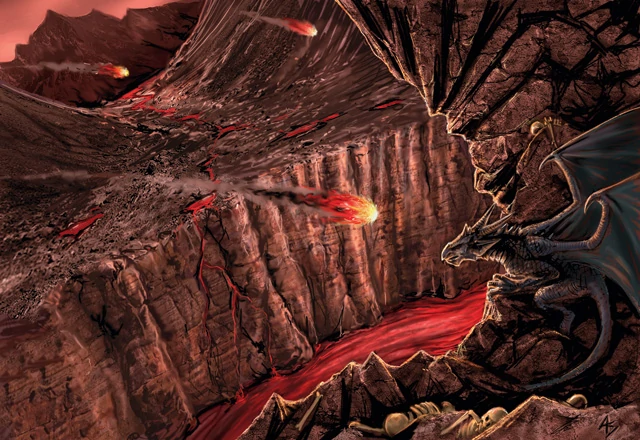Baator (/beɪˈɑːtɔːr/ bay-AH-tor)
The lower plane embodying Lawful Evil, and the home of the devils. It was a plane of sinister wickedness and institutional cruelty, its denizens organized into a strict caste system with a very rigid chain of command. Each of the nine Hells had its own physical laws or properties of matter, but all were inhospitable or deadly to outsiders.
Each of the Nine Hells was unique and usually mirrored the malevolent characteristics of its ruler, or perhaps the archdevils were shaped by the domains they schemed to control, no one can be certain. In earlier cosmologies, each Hell was a separate infinite layer rigidly joined to its neighbors by barriers at fixed locations. After the Spellplague, the domains of the archdevils were described as territories (large, but finite) or circles. The relationship between layers and circles is not fully known.
Layers
Avernus - The First Hell
By all accounts Avernus was a desolate wasteland with rocky terrain, sparse, twisted vegetation, concealed snake pits, caves and warrens, volcanoes, and rivers of magma. One of the main battlefields of the Blood War, Avernus echoed with the marching legions of devil troops preparing for the next campaign against the demons of The Abyss, and blood trickled out of the ground in vein-like streams eventually flowing into the river StyxDis - The Second Hell
The second circle of hell, when described as its own layer, was a flat barren plane containing little more than black, stagnant rivers, stretching for thousands of miles until it reached some rolling hills. In the center of this plane rose the Iron City of Dis, several miles in height and hundreds of miles wide.Minauros - The Third Hell
Minauros as a layer was described as an endless bog of vile pollution, decaying bodies, and rotting marsh, repeatedly drenched by rain, sleet, and hail storms. The soggy, bone-strewn, disease-ridden swampland made movement very difficult and was only broken occasionally by serpentine ridges of volcanic rock.Phlegetos - The Fourth Hell
The fourth circle was the Hell that most resembled the stereotype of a fiery world of eternal damnation, filled with active volcanoes, rivers of liquid fire, molten rock, ash hills, smoking pits, and unbearable heat, all wracked by tremors and earthquakes.Stygia - The Fifth Hell
The complete opposite of Phlegethos, Stygia was either a bottomless ocean covered by an ice sheet up to 3 miles (4.8 kilometers) thick, or a frozen sea salted with huge icebergs. A few floating islands were the only non-frozen ground in Stygia, their peaks wreathed in lightning arcing from the coal-black sky. Where lightning struck, a strange phenomenon called "cold fire" erupted: white flames of extreme cold that "burned" for a short time and then disappeared without a trace.Malbolge - The Sixth Hell
Malbolge was a gargantuan tumble of angular black stone blocks, each block ranging in size from a small city to a large metropolis, that formed a pile hundreds of miles thick. The randomly tilted and ill-fitting blocks were honeycombed with angular passages and caverns causing non-flying travelers to frequently need mountaineering skills and risk avalanches. Stinking clouds of vapor rose from the depths and lit the sky with the color of blood, causing cosmologists to speculate that the blocks of Malbolge may have rested on an infinite sea of lava. Corroborating reports have been heard of flammable materials left on the ground spontaneously combustingMaladomini - The Seventh Hell
The seventh Hell was often described as having vapor-polluted skies similar to Malbolge but the surface was solid. Filled with ruins of old cities, stagnant rivers, exhausted and abandoned quarries and strip mines, stone aqueducts and lava canals, decaying fortresses, swarms of biting flies, and black pools of ichor that erupted from the ground.Cania - The Eighth Hell
Cania was a bitterly cold realm of solid ice mountains, titanic, unnaturally fast-moving glaciers, and nearly continuous snowfall that made Stygia seem balmy by comparison. Unprotected travelers were exposed to temperatures of −60 ℉ (−51 ℃) but on the positive side, few creatures hunted in the icy wastes.Nessus - The Ninth Hell
The ninth and deepest Hell was a land of extremes: regions cold as Cania, volcanoes like Phlegethos, a lake of ice, a flaming forest, sheer cliffs, and firewinds. In the center of the plane was a blasted and torn landscape out of which rose Malsheem, the Citadel of Hell. It was said that Malsheem could hold millions of devils within its mountainous edifice, from the lowest warrens deep in the trench to the soaring spires miles above the tortured plane. A progression of rifts, pits and chasms lead down and down, forming a vertical maze hundreds of miles deep that contained great cities, fiendish armies, and the mighty fortress of the Overlord of HellInhabitants
The principal inhabitants of the Nine Hells/Baator were the devils, and their offspring in varieties too numerous to catalog here. See the main article for descriptions of the myriad devilkind. Unlike the demons of the Abyss, the devils were highly organized in their quest for power and status—scheming and plotting power plays, coups, and assassinations.
Languages
InfernalColor Pools
RubyEthereal Curtains
Red and BlackTuning Fork
Iron, F#Shape and Size
Nine Infinite LayersGravity
NormalTime
Normal
Alternative Name(s)
The Nine Hells
Type
Dimensional plane


Comments